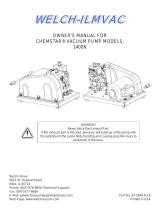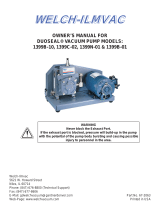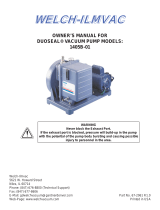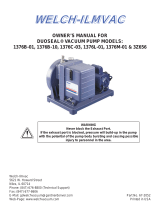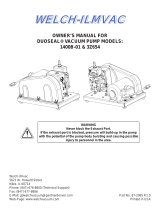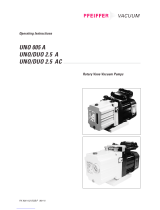Page is loading ...

Documents are only to be used and distributed completely and unchanged. It is strictly the users´ responsibility to check
carefully the validity of this document with respect to his product. Manual-no.: 999084 / 05/10/2009
page 1 of 46
Technology for Vacuum Systems
Instructions for use
Chemistry pumping units
PC 500 LAN
PC 600 LAN

Documents are only to be used and distributed completely and unchanged. It is strictly the users´ responsibility to check
carefully the validity of this document with respect to his product. Manual-no.: 999084 / 05/10/2009
page 2 of 46
After sales service:Contact your local dealer or call +49 9342 808-193.
Dear customer,
Your VACUUBRAND diaphragm pumps should support you for a long time without trouble and with maximal
power. Thanks to our long practical experience we have much information how you could ensure powerful
application and personal safety. Please read these instructions for use before the initial operation of your
pump.
VACUUBRAND diaphragm pumps are the result of many years of experience in construction and practical
operation of these pumps combined with the latest developments in material and manufacturing technology.
Our quality maxim is the ”zero fault principle”:
Every diaphragm pump, leaving our company, is tested intensively including an endurance run of 18 hours.
Therefore also faults, which occur rarely, are identified and can be eliminated immediately.
The achievement of the specifications after the endurance run is tested for every pump.
Every VACUUBRAND pump achieves the specifications. We feel obliged to this high quality standard.
We know that the vacuum pump can not take a part of your real work and hope that our products contribute
to an effective and trouble-free realisation of your work.
Yours
VACUUBRAND GMBH + CO KG

Documents are only to be used and distributed completely and unchanged. It is strictly the users´ responsibility to check
carefully the validity of this document with respect to his product. Manual-no.: 999084 / 05/10/2009
page 3 of 46
Attention! Important notes!
Not permitted! Misuse may cause damage.
Caution! Hot surface!
Isolate equipment from mains.
Note.
Contents
Safety information! ....................................................................................................4
Technical data............................................................................................................8
Use and operation ...................................................................................................12
Description ..............................................................................................................16
Notes on operation..................................................................................................18
General view of factory-set modes .........................................................................19
Menu structure of controller ...................................................................................20
Working with the controller .....................................................................................22
Readjustment ..........................................................................................................25
Interface parameters ...............................................................................................26
Read commands .....................................................................................................27
Write commands......................................................................................................29
Installation and accessories ...................................................................................31
Troubleshooting ......................................................................................................32
How to determine the best distillation conditions ................................................34
Replacing diaphragms and valves ........................................................................35
Cleaning the pressure transducer .........................................................................41
Calibration in the factory.........................................................................................42
Notes on return to the factory ................................................................................43
Health and safety clearance form ..........................................................................44

Documents are only to be used and distributed completely and unchanged. It is strictly the users´ responsibility to check
carefully the validity of this document with respect to his product. Manual-no.: 999084 / 05/10/2009
page 4 of 46
Safety information!
Remove all packing material, remove the product from its packing-box, remove the
protective covers from the inlet and outlet ports and keep, inspect the equipment and
check oil level.
If the equipment is damaged, notify the supplier and the carrier in writing within three
days; state the item number of the product together with the order number and the
supplier’s invoice number. Retain all packing material for inspection.
Do not use the equipment if it is damaged.
If the equipment is not used immediately, replace the protective covers. Store the
equipment in suitable conditions.
☞Read and comply with this manual before installing or operating the equip-
ment.
☞Transport the pump at the provided handles.
Use the equipment for the intended use only (for generation and measurement of
vacuum).
☞Prevent any part of the human body from coming in contact with the vacuum.
☞Comply with notes on correct vacuum and electrical connections.
☞Make sure that the individual components are only connected, combined and oper-
ated according to their design and as indicated in the instructions for use.
Comply with national safety regulations and safety requirements concerning the
use of vacuum and electrical equipment.
☞Equipment must be connected only to a suitable fused and protected electrical
supply and a suitable earth point. Failure to connect the motor to ground may result
in deadly electrical shock.
☞The supply cable may be fitted with a moulded European IEC plug or a plug suitable
for your local electrical supply. If the plug has been removed or has to be removed,
the cable will contain wires colour coded as follows: green or green and yellow:
earth; blue or white: neutral; brown or black: live.
☞Check that mains voltage and current conform with the equipment (see rating plate).
☞Ensure that the pump motor rotates in the correct direction. If it does not, the pump
and the vacuum system become pressurised, the system may burst.
☞If the equipment is brought from cold environment into a room for operation, allow
the equipment to warm up (pay attention to water condensation on cold sur-
faces).
☞Make sure ventilation is adequate if pump is installed in a housing or if ambient
temperature is elevated.
☞Do not operate the equipment if it is damaged.
Comply with all relevant safety requirements (regulations and guidelines) and adopt
suitable safety measures.
☞Provide a firm level platform for the equipment and check that the system to be
evacuated is mechanically stable and that all fittings are secure.
Attention: Flexible elements tend to shrink when evacuated.
Due to the high compression ratio of the pumps, pressure at the outlet port might be
generated being higher than the max. permitted pressure compatible with the mechani-
cal stability of the system.
☞Comply with permissible maximum pressures and pressure differences, see sec-
tion ”Technical data”. Do not operate the pump with overpressure at the inlet.
Do not permit any uncontrolled pressurizing (e. g. make sure that the exhaust pipe-
line cannot become blocked). If you have an exhaust-isolation valve, make sure that
you cannot operate the equipment with the valve closed. Risk of bursting!
☞Ensure that the system design does not allow the exhaust pipeline to become
blocked.

Documents are only to be used and distributed completely and unchanged. It is strictly the users´ responsibility to check
carefully the validity of this document with respect to his product. Manual-no.: 999084 / 05/10/2009
page 5 of 46
Permissible maximum pressure at the pressure transducer: 1.5 bar (absolute).
☞At pressures higher than 1060 mbar the display flashes. Error message ”p Er-
ror” appears, four beeps.
➨Immediate pressure relief necessary! Risk of bursting!
Attention: At pressures above 1100 mbar the device does no longer display the cor-
rect pressure values (pressure transducer saturated).
☞Ensure that the system design does not allow the coolant outlet pipeline to
become blocked.
☞Secure coolant hoses at the hose nozzles (e.g. with hose clip) to prevent their
accidental slipping.
☞Check liquid level in both catchpots regularly and drain condensate in time.
☞Check the overpressure safety relief device at the exhaust waste vapour con-
denser in appropriate intervals.
☞Avoid overpressure of more than 0.2 bar in case inert gas is connected.
☞The diameter of the inlet and outlet pipeline should be at the least as large as the
diameter of the pump connection pipelines.
To the best of our knowledge the equipment is in compliance with the requirements of
the applicable EC-directives and harmonized standards (see “Declaration of conform-
ity”) with regard to design, type and model, especially directive IEC 1010. This directive
gives in detail conditions, under which the equipment can be operated safely (see also
IP degree of protection).
☞Adopt suitable measures in case of differences, e. g. using the equipment outdoors,
installation in altitudes of more than 1000 m above mean sea level, conductive
pollution or dewiness.
Pay attention to symbol “hot surfaces“ on the equipment.
☞Adopt suitable measures to prevent any danger arising from the formation of hot
surfaces or electric sparks.
The pumps have no approval for operation in or for pumping of potentially ex-
plosive atmospheres.
If pumping different substances, purge the pump with inert gas prior to changing the
pumped media in order to pump out residues and to avoid reactions of the pumped
substances with each other with and the pump material.
Take into consideration interactions and chemical reactions of the pumped media.
The pumps are not suitable for pumping substances which may form deposits inside
the pump.
☞If there is a danger of the formation of deposits in the pump chamber (check inlet
and outlet of the pump) inspect the pump chamber regularly and clean if necessary.
The pumps are not suitable to pump unstable substances and substances which
react explosively under impact (mechanical stress) and/or when being exposed to
elevated temperatures without air.
The pumps are not suitable to pump self inflammable substances, substances which
are inflammable without air and explosive substances.
The pumps are not suitable for pumping dust and have no approval for operation
below ground.
☞Adopt suitable measures to prevent the release of dangerous, explosive, corrosive
or polluting fluids.
☞Use inert gas for gas ballast or venting if necessary.
☞The user must take suitable precautions to prevent any formation of explosive
mixtures in the expansion chamber. In case of a diaphragm crack, mechanically
generated sparks, hot surfaces or static electricity may ignite these mixtures.
☞Take adequate precautions to protect people from the effects of dangerous sub-
stances (chemicals, thermal decomposition products of fluoroelastomers), wear
appropriate safety-clothing and safety glasses.
☞Comply with applicable regulations when disposing of chemicals. Take into consid-
eration that chemicals may be polluted.

Documents are only to be used and distributed completely and unchanged. It is strictly the users´ responsibility to check
carefully the validity of this document with respect to his product. Manual-no.: 999084 / 05/10/2009
page 6 of 46
In case of overload the motor is shut down by a thermal cutout in the winding.
☞Attention: Manual reset is necessary. Switch off the pump or isolate the equipment
from mains. Wait approx. five minutes before restarting the pump
☞Attention: In case of supply voltage below 100V, the lock of the cutout might be
restricted and the pump might restart on its own after sufficient cooling down. Take
suitable precautions, if an automatic restart of the pump may lead to a critical
dangerous situation.
☞Avoid high heat supply (e. g. due to hot process gases).
☞Ensure sufficient air admittance if pump is installed in a housing.
Due to the residual leak rate of the equipment, there may be an exchange of gas,
albeit extremely slight, between the environment and the vacuum system.
☞Adopt suitable measures to prevent contamination of the pumped substances or
the environment.
Pumping at high inlet pressure may lead to overpressure at the gas ballast valve.
☞Pumped gases or condensate might be pushed out in case the valve is open.
☞If an inert gas supply is connected, ensure that the inlet pipeline is not contaminated.
The controller is equipped with a short circuit proof wide-range power supply with
integrated overload protection and with a fuse 8A(T).
Check the level of condensate in the round bottom collecting flask regularly. Do not
overfill the collecting flask.
Ensure that in case of failure the pump and the vacuum system always will turn into a
safe status.
☞In case of diaphragm cracks or leaks in the manifold, pumped substances might be
released into the environment or into the pump housing. To reduce the risk of leaks,
ask for a diaphragm pump with additional safety diaphragm.
☞Comply especially with notes on operation and use and maintenance.
☞Failure of the pump (e. g. due to power failure) must not lead to a critical dangerous
situation under any circumstances.
Electronic equipment is never 100% fail-safe. This may lead to an indefinite status of
the equipment. Provide protective measures against malfunction and failure.
☞Operating the pump, stand still of the pump or operating the venting valve must not
lead to a critical dangerous situation under any circumstances.
Attention: If Auto-Start (Auto-St.) is preselected, the process starts immediately
after switching on the controller without pressing any further key. It is the user’s respon-
sibility to ensure that no dangerous status of the system due to the automatic startup
of the pump, e.g. after a power failure, can occur and to provide appropriate safety
measures. If necessary, the user has to check prior to using the equipment if the
option ”Auto-Start” is enabled.
Use only genuine spare parts and accessories.
☞Otherwise safety and performance of the equipment as well as the electromagnetic
compatibility of the equipment might be reduced.
Possibly the CE mark or the C/US conformity becomes void if not using genuine
spare parts.
The A-weighed emission sound pressure level of the pump does not exceed 70 dB(A).
Measurement according to EN ISO 2151:2004 and EN ISO 3744:1995 with standard
silencer or exhaust tube at outlet.
Ensure that maintenance is done only by suitable trained and supervised techni-
cians. Ensure that the maintenance technician is familiar with the safety procedures
which relate to the product processed by the vacuum system and that the equipment,
if necessary, is appropriately decontaminated before starting maintenance.
Comply with local and national safety regulations.

Documents are only to be used and distributed completely and unchanged. It is strictly the users´ responsibility to check
carefully the validity of this document with respect to his product. Manual-no.: 999084 / 05/10/2009
page 7 of 46
Wear parts have to be replaced regularly. In case of normal wear the lifetime of the
diaphragms and valves is > 10000 operating hours. Bearings have a typical durability
of 40000 h. Motor capacitors have a typical durability in the range of 10000 to 40000 h
depending strongly on the operation conditions like ambient temperature, humidity or
load.
☞Check every capacitor regularly by measuring its capacity and estimating its opera-
tion time. Exchange old capacitors early enough to prevent a failure. If an overaged
motor capacitor fails it might get hot and even melt and may cause a flame to form
which could be dangerous for persons and equipment in the vicinity. The ca-
pacitors have to be replaced by an electrician.
➨Isolate equipment from mains and wait two minutes before starting mainte-
nance to allow the capacitors to discharge.
➨Before starting maintenance, wait two minutes after isolating the equipment from
mains to allow the capacitors to discharge.
☞Attention: The pump might be contaminated with process chemicals which have
been pumped during operation. Ensure that the pump is decontaminated before
maintenance and take adequate precautions to protect people from the effects of
dangerous substances if contamination has occurred.
☞Before starting maintenance vent the pump, isolate the pump and other compo-
nents from the vacuum system. Allow sufficient cooling of the pump. Drain conden-
sate, if applicable.
In order to comply with law (occupational, health and safety regulations, safety at work
law and regulations for environmental protection) vacuum pumps, components and
measuring instruments returned to the manufacturer can be repaired only when certain
procedures (see section ”Notes on return to the factory”) are followed.
☞Ensure that the pump cannot be operated accidentally. Never operate the pump
if covers or other parts of the pump are disassembled. Never operate a defec-
tive or damaged pump.

Documents are only to be used and distributed completely and unchanged. It is strictly the users´ responsibility to check
carefully the validity of this document with respect to his product. Manual-no.: 999084 / 05/10/2009
page 8 of 46
Technical data
We reserve the right for technical modification without prior note!
* Pumping speed of diaphragm pump
epyT NAL005CP NAL006CP
)23482NID(zH06/05*deepsgnipmuPm
3
h/1.2/9.1).xam(5.3/0.3
)etulosba(muucavetamitlUrabm9 2
tsallabsaghtiw)etulosba(muucavetamitlUrabm519
)etulosba(er
usserpteltuoelbissimrep.xaMrab1.1
)etulosba(tsallabsagtaerusserpelbissimrep.xaMrab2.1
erutarepmettneibmaelb
issimreP
egarots
noitarepo
C°C° 06+ot01- 04+ro03+ot01+ CEIfoyticapacgnikaerbees( )1CNVfotekcos
gniruderutsiom
cirehpsomtaevitalerelbissimreP
)noitasnednocon(noitarepo
%58ot03
rewoPW081002
zH06/05deepsdaol-oNnim
1-
0081/0051
tatnerrucdetaR V001zH06/05~ zH06~V021 zH06/05~V032
A
A
A
8.3/6.3 0.3 6.1/6.1
8.4/8.3 2.4 9.1/7.1
egatlovylp
pusfoegnarelbissimrepmumixaM
gnitarfosnoitacificepsevresbO:noitnettA
!etalp
zH06/05%01-/+~V001 zH06%01-/%5+~V021 zH06/05%01-/+~V032
noitcetorprotoM tuotuclamreht
925CEInoitcetorpfoeergeD 02PI
telnI gnibutEFTProfgn
ittifwoble 8/01WN
teltuO 01WNelzzonesoh
retawgniloocfonoitcennoC 6WNelzzonesoh
HxWxLsnoisnemiDmm594x062x053594
x572x053
.xorppathgieWgk1.519.02
noitidnocgnitarepO erusserptelnI sagfoegnardettimreP
telnitaserutarepmet
noitareposuounitnoC)daolsaghgih(rabm001> ➨C°04+otC°01+
noitareposu
ounitnoC)daolsagwol(rabm001< ➨C°06+otC°0
)setunim5<(noitarepoemit-trohS)daolsagwol(rabm001< ➨C°08+otC°01-
Gas inlet temperatures:

Documents are only to be used and distributed completely and unchanged. It is strictly the users´ responsibility to check
carefully the validity of this document with respect to his product. Manual-no.: 999084 / 05/10/2009
page 9 of 46
* The actual available range of the vacuum control can be limited due to the ultimate vacuum of the pump, the developed amount of gas, etc.
** ohm resistive (inductive) load
rellortnoC 1CNV
recudsnarterusserP edamrecudsnarterusserpetulosbaeviticapac cimarecedixomuinimulafo
yalpsiD sretcarahc8x2
,yalpsidDCLlaciremunahpla
dehctiwsebot(noisrevnocelacscinortcelE )neewteb aPhrorroT,rabm
)etulosba(egnart
nemerusaeM )rroT1-rroT528(rabm1-rabm0011
*)etulosba(lortnocmuucavfoegnarmumixaM )rroT1-rroT597(rabm1-rab
m0601
ylluferacrecudsnarthtiw(ytniatrecnU )erutarepmettnatsnoctadnadetarbilac tigid1-/+)rroT57,0(rabm1-/
+<
tneiciffeocerutarepmeT )K/rroT50,0(K/rabm70,0-/+<
noitarepotaerutarepmettneibmaelbissimreP C°04+otC°01
egarotstaerutarepmettneibmaelbissimreP C°07+otC°01-
erutsiomcirehpsomtaevitalerelbissimreP )noitasnednoc
on(noitarepognirud %58ot%03
ylppusegatlovfoegnarelbissimrepmumixaM zH06/05)%01+(~V032ot)%01-(~V001
esuF V0
52/A8T,mm02x5
)noitarepodaol-on(wardrewoP AV3
DNARBUUCAVhtiwwardrewoP retawgniloocdnaevlavnoitalosi-C6VV e
vlav
)tuptuohctiwstuohtiw(AV01mumixam
:tekcosedoidfoyticapacgnikaerB zH06/05V032-011ylppusegatlov zH06/05
V011-001ylppusegatlov noitareposuoenatlumisehtrofdengised lanigirogniwollofehthtiw)noitcennoclellarap( seirossecca
Am004.xam,V42 Am043.xam,V42
C6VVevlavnoitalosi- =V42evlavretawgnilooc-
**tekcosCEIfoyticapacgni
kaerB C°03erutarepmettneibma C°04erutarepmettneibma ~V521A)2,7(2,7,~V052A)4(2,7 ~V521A)6(6,~V052A)4(6
925C
EIotgnidroccanoitcetorpfoeergeD 02PI
noitcennocmuucaV EFTProf8/01WNnoitcennocesohdewercs gnibut
erusserpta
erusserpelbissimrepmumixaM )etulosba(recudsnart )rroT5211(rab5.1
suoesagfoerutarepmetelbissimrepmumixaM r
ecudsnarterusserptaaidem C°08otpusdoireptrohsrof
)tekcosedoidaiv(tupnirorrelanretxE V42-5
ecafretnilaireS C232SR
We reserve the right for technical modification without prior note!

Documents are only to be used and distributed completely and unchanged. It is strictly the users´ responsibility to check
carefully the validity of this document with respect to his product. Manual-no.: 999084 / 05/10/2009
page 10 of 46
We reserve the right for technical modification without prior note!
stnenopmoC strapdetteW
tinugnipmuP
teltuOTBP
telnIEFTCE/EFTE
esoHEFTP
gnittiFEFTCE/EFTE
tophctacehttasgnir-OMPF
ecivedfeilerytefaserusserprevO rebb
urnocilis/liofEFTP
etalprevoctophctaCPP
gnitcelloc,resnednocruopavetsawtsuahxE
ksalf
detaocssalgetacilisor
ob;ssalgetacilisoroB
pmuP
tresnirevocgnisuoH decrofniernobracEFTP
revocdaeH decrofniererbifnobracEFTE
csidgnipmalcmgarhpaiD decrofni
ererbifnobracEFTE
evlaVMKFF
mgarhpaiDEFTP
rellortnocmuucaV
noitcennocesoh/noitcennocmuucaV PP,EFTE/leetssselniatS
laeS remotsaleoroulftnatsiseryllacimehc
gnisuohros
neSleetssselniatS
rosneS cimarecedixomuinimula

Documents are only to be used and distributed completely and unchanged. It is strictly the users´ responsibility to check
carefully the validity of this document with respect to his product. Manual-no.: 999084 / 05/10/2009
page 11 of 46
exhaust waste vapour
condenser with cover
overpressure safety relief
device at the exhaust
waste vapour condenser
inlet
(vacuum connection)
round bottom
flask to collect
condensate
pump MZ 2C
gas ballast valve
PC 500 LAN controller VNC 1
vacuum connection VNC 1
connection
pump
mains connection
VNC 1
on/off switch
diaphragm pump
(at the terminal box)
on/off switch
controller
exhaust waste vapour
condenser with cover
overpressure safety relief
device at the exhaust
waste vapour condenser
inlet
(vacuum connection)
round bottom
flask to collect
condensate
pump MD 4C
PC 600 LAN controller VNC 1
vacuum connection VNC 1
connection
pump
mains connection
VNC 1
on/off switch
diaphragm pump
(at the terminal box)
on/off switch
controller
fuse
fuse

Documents are only to be used and distributed completely and unchanged. It is strictly the users´ responsibility to check
carefully the validity of this document with respect to his product. Manual-no.: 999084 / 05/10/2009
page 12 of 46
Use and operation
overpressure
safety relief
device
catchpot at
the outlet
catchpot at
the inlet
coolant outlet
(hose nozzle 6 mm)
coolant inlet
(hose nozzle 6 mm)
outlet
(gas!; hose nozzle 10 mm)
Assembly of enclosed components
Round bottom flasks:
The catchpot at the inlet prevents droplets and particles from
entering the pump.
☞Lifetimes of diaphragms and valves are enhanced.
☞Improves vacuum in case of condensation.
Both round bottom flasks are coated with a protective layer to
prevent disintegration in case of breakage or implosion.
➨Assemble the catchpots at the inlet and at the outlet using
joint clips.
Exhaust waste vapour condenser:
➨Assemble hose nozzles for coolant inlet and coolant outlet
pipelines at the exhaust waste vapour condenser.
The exhaust waste vapour condenser enables an efficient
condensation of the pumped vapours at the outlet.
☞No backflow of condensates.
☞Controlled recovery of condensates.
☞Next to 100% solvent recovery.
☞The isolation cover protects against glass splinters in case
of breaking, acts as thermal isolation to avoid condensation
of humidity and is intended to absorb shocks.
➨Attach the pipelines of the coolant circuit to the respective hose nozzles (see im-
age) at the waste vapour condenser. Check hose connections prior to starting op-
eration of the cooling system.
➨Secure coolant hoses at the hose nozzles (e.g. with hose clip) to prevent their
accidental slipping.
☞Ensure that the coolant outlet pipeline is always free and that it cannot get blocked.
☞Install an optional coolant valve always only in the inlet line of the exhaust waste
vapour condenser.
☞The gas outlet (hose nozzle 10 mm) must not be blocked. The exhaust pipeline has
always to be free and pressureless to enable an unhindered discharge of gases.
☞Connect the exhaust to a suitable treatment plant to prevent the discharge of dan-
gerous gases and vapours to the surrounding atmosphere.
Installing in a vacuum system:
☞Avoid throttling losses by using connecting pipes with large diameter and keep
them as short as possible.
☞Reduce the transmission of vibration and prevent loading due to rigid pipelines.
Insert elastic hoses or flexible elements as couplings between the pump and rigid
pipes. Attention: Flexible elements tend to shrink when evacuated.
☞Use a suitable valve to isolate the pump from the vacuum system to allow the
pump to warm up before condensable vapours are pumped or to clean the pump
before it is switched off.
☞Connect the exhaust to a suitable treatment plant to prevent the discharge of dan-
gerous gases and vapours to the surrounding atmosphere. Use a catchpot to pre-
vent the drainage of contaminated condensate back into the pump.

Documents are only to be used and distributed completely and unchanged. It is strictly the users´ responsibility to check
carefully the validity of this document with respect to his product. Manual-no.: 999084 / 05/10/2009
page 13 of 46
Prior to use:
☞Maximum ambient temperature: 30 °C or 40 °C (See ”Technical Data - VNC 1”).
☞Make sure ventilation is adequate if pump is installed in a housing or if ambient
temperature is elevated. Keep a distance of minimum 20 cm between fans and
ambient parts.
☞If pump is installed in altitudes of more than 1000 m above mean sea level check
compatibility with applicable safety requirements, e. g. IEC 60034 (motor may over-
heat due to insufficient cooling).
☞If the gas ballast valve is open, a power failure may cause unintentional ventilation
of the pump. In case this constitutes a potential source of danger, take appropriate
safety measures.
☞When assembling, ensure vacuum-tightness. After assembly, check the complete
system for leaks.
During operation:
Do not start pump if pressure difference between inlet and outlet port exceeds maxi-
mum 1 bar. Attempts to start pump at higher difference may cause blockade and
damage of the motor.
☞Check compatibility with permissible maximum pressure at outlet and maxi-
mum pressure difference between inlet and outlet ports. Due to the high compres-
sion ratio of the pumps, pressure at the outlet port might be generated being higher
than the max. permitted pressure compatible with the mechanical stability of the
system.
The pump achieves its pumping speed, ultimate total vacuum and vapour pumping
rate only at operating temperature (after approx. 15 minutes).
☞Prevent internal condensation, transfer of liquids or dust. The diaphragm and valves
will be damaged, if liquids are pumped in significant amounts.
☞Let the pump run with gas ballast to reduce condensation of pumped substances
(water vapour, solvents, ....) in the pump.
In case of overload the motor is shut down by a thermal cutout in the winding.
☞Manual reset is necessary. Switch off the pump or isolate the equipment from mains.
Wait approx. five minutes before restarting the pump. Identify cause of failure and
eliminate.
☞Attention: In case of supply voltage below 100V, the lock of the cutout might be
restricted and the pump might restart on its own after sufficient cooling down. Take
suitable precautions, if an automatic restart of the pump may lead to a critical
dangerous situation
Permissible maximum pressure at the pressure transducer
(vacuum connection at controller): 1.5 bar (absolute).
☞At pressures higher than 1060 mbar the display flashes.
Error message ”p Error” appears, four beeps.
➨Immediate pressure relief necessary! Risk of bursting!
Attention: At pressures above 1100 mbar the device does
no longer display the correct pressure values (pressure trans-
ducer saturated).
vacuum connection at the controller
☞Comply with permissible maximum pressure and pressure differences at the pump.
☞Inside a vacuum system where evaporation occurs, e. g. rotary evaporator, the vacuum is not uniform.
This effects the measured pressure and thus the process control. E.g. a condenser acts as pump or the
vacuum in the pipeline is lower than in the system. Therefore carefully choose position where to instal
the vacuum connection to the controller.
☞In order to avoid malfunction it is important to position the controller so as to avoid flow of condensate
towards the pressure transducer.

Documents are only to be used and distributed completely and unchanged. It is strictly the users´ responsibility to check
carefully the validity of this document with respect to his product. Manual-no.: 999084 / 05/10/2009
page 14 of 46
Attention: Important notes regarding the use of gas ballast
☞Make sure that air/gas inlet through the gas ballast valve never lead to hazardous,
explosive or otherwise dangerous mixtures. If in doubt, use inert gas.
☞When using air rather than inert gas, risk of significant damage to equipment and/or
facilities, risk of personal injury or even loss of life exists due to the formation of
hazardous and/or explosive mixtures if air and pumped media react inside or at the
outlet of the pump.
For condensable vapours (water vapour, solvents, ...):
☞Do not pump vapour before pump has reached its operating
temperature and with gas ballast valve closed.
☞Open gas ballast valve. (Closing of gas ballast valve by turn-
ing 180°.)
☞The gas ballast valve is open if the arrow on the gas ballast
cap shows away from the pump.
☞With gas ballast valve open ultimate vacuum will be reduced,
pumping speed is decreased.
☞Use inert gas at the air inlet to avoid the formation of explo-
sive mixtures.
gas
ballast
In case of low boiling solvents when the formation of condensate is unlikely, the use of
gas ballast might be unnecessary.
☞Operating the pump without gas ballast increases the solvent recovery rates at the
exhaust waste vapour condenser.
Attention: Notes concerning the operation of the exhaust waste vapour condenser
➨Check hose connections prior to starting operation of the cooling system.
➨Check coolant hoses regularly during operation.
☞Ensure that the coolant outlet pipeline is always free and that it cannot get blocked.
☞Maximum permissible coolant pressure at the exhaust waste vapour condenser:
6 bar (absolute)
☞Comply with the maximum permissible coolant pressures of additional components
in the coolant circuit (e.g coolant valve).
☞Avoid overpressure in the coolant circuit (e.g. caused by blocked or squeezed cool-
ant hoses).
☞Permissible range of coolant temperature at the exhaust waste vapour condenser:
-15°C to +20°C
☞The gas outlet (hose nozzle 10 mm) must not be blocked. The exhaust pipeline has
always to be free and pressureless to enable an unhindered discharge of gases.
➨Check the overpressure safety relief device at the exhaust waste vapour condenser
regularly, replace if necessary. Check especially for sticking and cracks.
☞Connect the exhaust to a suitable treatment plant to prevent the discharge of dan-
gerous gases and vapours to the surrounding atmosphere.
In case of condensation:
➨Check liquid level in both catchpots during operation. Avoid overflowing of the catch-
pots.
☞Do not overfill the catchpots. Maximum liquid level approx. 80%, to avoid problems
when removing the catchpots.
➨Check liquid level in both catchpots regularely and drain catchpots in time.
Removing the catchpots:
Catchpot at outlet:
➨Remove joint clip, remove catchpot and drain condensate.

Documents are only to be used and distributed completely and unchanged. It is strictly the users´ responsibility to check
carefully the validity of this document with respect to his product. Manual-no.: 999084 / 05/10/2009
page 15 of 46
Catchpot at inlet:
➨Admit air or inert gas (via inlet of pumping unit) to atmospheric pressure. Remove
joint clip, remove catchpot and drain condensate.
➨Reassemble drained catchpots.
Important: Comply with regulations when disposing solvents/condensates. Reuse if
possible, purify if contaminated.
Shutdown:
Short-term:
Has the pump been exposed to condensate?
☞Allow the pump to continue to run at atmospheric pressure for a few minutes.
Has the pump been exposed to media which may damage the pump materials or forms
deposits?
☞Check and clean pump heads if necessary.
Long-term:
➨Take measures as described in section short-term shutdown.
➨Separate pump from the apparatus.
➨Drain catchpots.
➨Close inlet and outlet port (e. g. with transport caps).
➨Store the pump in dry conditions.

Documents are only to be used and distributed completely and unchanged. It is strictly the users´ responsibility to check
carefully the validity of this document with respect to his product. Manual-no.: 999084 / 05/10/2009
page 16 of 46
Description
After the connection of components the controller can be operated in different basic
modes, see ”Basic modes and menu structure”.
When switching on the controller, the current basic mode and the number of version
are displayed for 2s.
Display and keys
key ”up”
- select menu
- next menu item
- increase value
key ”down”
- select menu
- previous menu item
- decrease value
key ”Enter”
- start of control
- next step in menu setting
- adopt set value and quit menu
Display
In menus
line1: caption
line 2: menu item
In submenus (only setting of RS 232C)
line 1: menu item (RS232)
line 2: submenu
After selection of menu item
line 1: menu item (or submenu)
line 2: value to be set
In program
line 1: pressure
line 2: status message
mains switch
key ”Esc”:
- go to previous level of program
(operation menu)
- interruption of operation (reset to
previous settings)
- stop of control

Documents are only to be used and distributed completely and unchanged. It is strictly the users´ responsibility to check
carefully the validity of this document with respect to his product. Manual-no.: 999084 / 05/10/2009
page 17 of 46
Connections
serial interface
RS 232 C
vacuum connection
connection mains cable
8-pin socket for connection of
coolant valve or isolation valve
or speed control signal (PWM)
cover
fuse switch output
connection of pump or of
valve according to power supply
(switch output)

Documents are only to be used and distributed completely and unchanged. It is strictly the users´ responsibility to check
carefully the validity of this document with respect to his product. Manual-no.: 999084 / 05/10/2009
page 18 of 46
Notes on operation
For operation it is necessary to install valves and/or vacuum pumps.
Max. permitted pressure at pressure transducer: 2 bar (abso-
lute).
☞The display flashes at a pressure higher than 1060 mbar.
☞Comply with max. permitted pressure of 2 bar absolute.
☞Inside a vacuum system where evaporation occurs, the
vacuum is not uniform. This effects the value of the meas-
ured pressure and such the controlling. Therefore carefully
choose the position where to connect the pressure trans-
ducer.
☞Condensate and deposits at the pressure transducer falsify
the measurement result.
☞If residues occur or when working with aggressive or con-
densable substances, install a gas washing bottle in front of
the pressure transducer.
☞Position controller in such a way, that condensate can
not flow into the pressure transducer.
☞If necessary, clean pressure transducer, see section ”Clean-
ing the pressure transducer”.
☞Setting of interface parameters, see ”Interface parameters”.
☞Presettings at controller, see ”’Factory-set modes and menu structure”.
☞Operating the controller, see ”Working with the controller”.
vacuum
connection
Assignment of pins
6
7
8
3
2
1
5
4
1 coolant valve
2 + 24V
3 isolation valve
4 external error -
5 external error +
6 mass (PWM -)
7 PWM + (speed control signal for VARIO pumps)
8 +12 V
Note: Texts written in Courier font mirror the display of the LCD of the controller.

Documents are only to be used and distributed completely and unchanged. It is strictly the users´ responsibility to check
carefully the validity of this document with respect to his product. Manual-no.: 999084 / 05/10/2009
page 19 of 46
General view of factory-set modes
VNC 1
press key during switching on
* only with speed controlled VACUUBRAND VARIO pumps
** designated for VACUUBRAND diaphragm pumps type ME 16(C), MD 8(C),
MD 12(C) und MV 10(C)
Esc
VACUULAN
V. 2.00
Attention: When connecting pumps pay attention to the breaking capacity of the
IEC socket (see ”Technical Data”)!
Factory-set mode ”Vacuum control” (pControl)
Controller controls
- pump and / or isolation valve according to preset pressure in two-
point controller continuous pumping
- VARIO pump exactly according to preset pressure*
- coolant valve
Factory-set mode ”VACUU•LAN” (VACUULAN)
Controller controls
- pump according to preset pressure and time
- VARIO pumps according to preset pressure and time*
- coolant valve
Factory-set mode ”VACUU•LAN” for pumps with 8 cylinders** (VCL
8cyl)
Controller controls
- pump according to preset pressure and time
- coolant valve
Factory-set mode ”RC 5/RC 6 management” (RC 5/RC 6)1)
Controller controls
- chemistry-HYBRID-pump (pressure check)
- isolation valve
- bypass valve
- coolant valve
1) Attention: For factory-set mode ”RC 5/RC 6 management” please order sepa-
rate instructions for use!
factory-set mode

Documents are only to be used and distributed completely and unchanged. It is strictly the users´ responsibility to check
carefully the validity of this document with respect to his product. Manual-no.: 999084 / 05/10/2009
page 20 of 46
VACUULAN
V. 2.00
after 2 sec
Esc
Switch on
Menu structure of controller
Esc
Program menu
see section
”Working with the
controller”
”Program menus”
1013mbar
Start ↵↵
↵↵
↵
Start of program
within
2 sec
within
2 sec
Device menu
see next page
• Readjustment
• RS 232 parameters
• Sound
• Units of pressure
• Auto start
• Language
• Time delay (not for VACUULAN)
• Control (only with RC 5/RC 6)
• External error input
Function menu
Function
Cont.pum
Function
pControl
EscEsc
↵↵
↵↵
↵
Esc
only possible in ”vacuum control”
Function menu:
• Setting of the basic function of the controller (only in ”vacuum control” (pControl)).
Device menu:
• Setting of the device specific features and the periphery of the controller.
- Readjustment: Adjusting the pressure transducer at atmospheric pressure and under vacuum, see
section ”Readjustment”.
- RS 232 parameters: Setting of the interface parameters, see section ”Interface parameters”.
- Sound: Switching on/off the function ”acoustic warning signal”.
- Pressure unit: Selection of the pressure unit mbar, Torr or hPa.
- Auto start: Process starts immediately after switching on the controller.
- Language: Selection of the language in the menus (English, German, French).
- Time delay: Delayed switching off of the cooling water and the pump (not for VACUULAN)
- Control: Control of a valve or a pump via the IEC control line (only for RC 5/RC 6).
- External error input: In case of failure of the signal the control sends an error message and switches off
the pump, if preset.
Attention: When operating a VARIO pump the external error input is used to indi-
cate a failure of the frequency converter and can not be wired externally.
Program menu:
• Setting of the function specific parameters (e. g. preset pressure).
Attention: Depending on factory-set configurations some menu options are not active!
↵↵
↵↵
↵
Notes on menu structure of the controller
/
